Click on images to enlarge
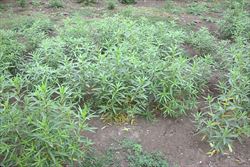
infestation of young plants (Photo: Sheldon Navie)
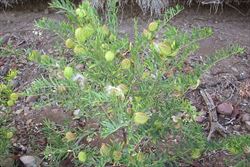
much-branched habit (Photo: Sheldon Navie)
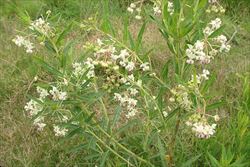
habit in flower (Photo: Sheldon Navie)
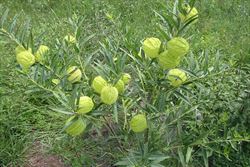
habit in fruit (Photo: Sheldon Navie)
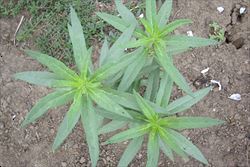
elongated leaves (Photo: Sheldon Navie)

flower cluster (Photo: Sheldon Navie)
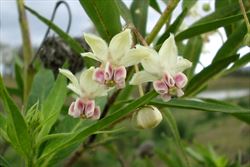
close-up of flowers (Photo: Sheldon Navie)
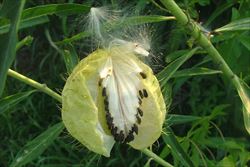
mature fruit beginning to release its seeds (Photo: Sheldon Navie)
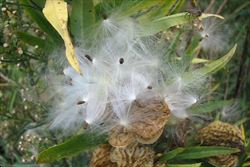
old fruit with seeds (Photo: Sheldon Navie)
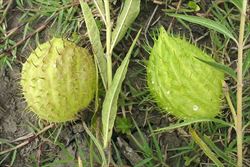
comparison of the fruit of balloon cotton bush (Gomphocarpus physocarpus), on the left, and narrow-leaved cotton bush (Gomphocarpus fruticosus), on the right (Photo: Sheldon Navie)
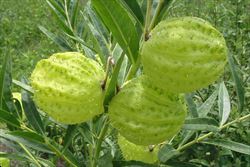
inflated immature fruit with short 'spines' (Photo: Sheldon Navie)
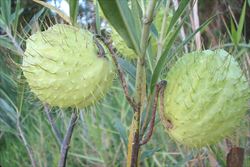
stems and immature fruit with longer 'spines' (Photo: Sheldon Navie)
Scientific Name
Gomphocarpus physocarpus E. Mey.
Synonyms
Asclepias fruticosa L. (misapplied)Asclepias physocarpa (E. Mey.) Schltr.Asclepias semilunata (A. Rich.) N.E. Br.Gomphocarpus brasiliensis Fourn. (misapplied)
Family
Asclepiadaceae (Victoria, the ACT, Tasmania, South Australia, Western Australia and the Northern Territory)Apocynaceae (Queensland and New South Wales)
Common Names
balloon cotton bush, balloon cotton-bush, balloon cottonbush, balloon gomphocarpus, balloon plant, balloonplant, bladderbush, Cape cotton, cotton bush, cottonbush, gomphocarpus, swan plant, wild cotton
Origin
Native to southern Africa (i.e. South Africa, Swaziland and southern Mozambique).
Cultivation
Balloon cotton bush (Gomphocarpus physocarpus) was probably introduced as a garden ornamental, however it is not common in cultivation any more.
Naturalised Distribution
A widely naturalised species that is most common in the eastern parts of the country. It is very common in the coastal and sub-coastal districts of central and southern Queensland and in the north-eastern corner of New South Wales. Less common or occasional in northern Queensland, in other parts of New South Wales, in south-eastern South Australia, and near Perth in south-western Western Australia. Also naturalised on Norfolk Island and Lord Howe Island.
Naturalised overseas in Mauritius, India, Sri Lanka, Hong Kong, Hawaii, New Caledonia, the Caribbean and beyond its native range in Africa.
Habitat
A weed of pastures, open woodlands, grasslands, wetlands, disturbed sites, waste areas, roadsides, fallows, and plantation crops (e.g. sugar cane) in the sub-tropical, tropical, and warmer temperate regions of Australia.
Habit
A small, upright (i.e. erect) and occasionally-branched shrub usually growing 0.5-2 m tall, but occasionally reaching up to 2.5 m in height.
Distinguishing Features
- a small shrubby plant usually growing up to 2 m tall.
- its stems and elongated leaves (3.5-12 cm long and 5-16 mm wide) exude a milky sap when damaged.
- its clusters of white or pinkish flowers have a crown-like structure at its centre.
- its distinctive balloon-like fruit (5-7.5 cm long) are covered with soft spines (7-10 mm long).
- these fruit contain many black seeds topped with silky tufts of white hairs.
Stems and Leaves
The stems are occasionally branched and younger stems are covered with short soft hairs. A poisonous, milky-white, sap (i.e. latex) exudes from damaged stems and leaves.
The oppositely arranged leaves are long and narrow (i.e. narrowly lanceolate to narrowly elliptic) with pointed tips (i.e. acute apices) and a gradually narrowed (i.e. attenuate) base. These leaves (3.5-12 cm long and 5-16 mm wide) are borne on stalks (i.e. petioles) 3-10 mm long and have entire margins. Their upper surfaces are green and hairless (i.. glabrous), while their undersides are often paler green and finely hairy (i.e. sparsely pubescent), particularly along the central vein (i.e. mid-rib).
Flowers and Fruit
Individual flowers (12-13 mm across) have five white petals (6-11 mm long) and a crown-like structure (i.e. corona) at the centre which may be white or pinkish in colour. They are borne in small drooping clusters of 4-10 flowers near the tips of the branches, with the individual flower stalks (i.e. pedicels) all radiating from the same point (i.e. in umbels). The main stalk of each flower cluster (i.e. peduncle) is 2-3.5 cm long and emanates from one of the upper leaf forks (i.e. axils), while the individual flower stalks (i.e. pedicels) are 10-25 mm long and finely hairy. The flowers also have five small sepals (3-4 mm long) and five stamens.
The distinctive inflated fruit (i.e. sub-globose follicles) are balloon-like in appearance (5-7.5 cm long and 4-5.5 cm wide) and covered with soft spines (7-10 mm long). They are abruptly pointed, with a very short beak that is usually sunken into the indented tip of the fruit. These fruit contain numerous small black seeds (about 4.5 mm long and 2 mm wide), that are topped with a tuft of silky-white hairs about 3 cm long.
Reproduction and Dispersal
This species reproduces mainly by seed. These seeds are most commonly spread by wind and water. They may also be dispersed as a contaminant of agricultural produce (e.g. fodder) or in mud attached to animals, machinery and other vehicles.
Environmental Impact
Balloon cotton bush (Gomphocarpus physocarpus) is mainly regarded as an environmental weed in Queensland. This species invades grasslands, open woodlands, pastures, floodplains and wetland margins, where it replaces native species and can form relatively dense infestations. It is listed among the top 100 most invasive plant species in south-eastern Queensland and appears on several local environmental weed lists in this region (e.g. in Maroochy Shire, Cooloola Shire, Redland Shire and Ipswich City). Balloon cotton bush (Gomphocarpus physocarpus) has also been recorded in conservation areas in south-eastern Queensland (e.g. in Conondale National Park, the Pimpama River Conservation Area and in recently established conservation areas at Springbrook).
This species is common in waste places and on river banks north from the Camden district in New South Wales, and is listed as a common exotic species in the Demon Nature Reserve at Tenterfield in north-eastern New South Wales. It also grows near salt lakes and in winter-wet sites on the Swan Coastal Plain in south-western Western Australia and has been recorded in Belair National Park in south-eastern South Australia.
Other Impacts
Balloon cotton bush (Gomphocarpus physocarpus) is poisonous to livestock and humans and infestations may also reduce the productivity of pastures.
Legislation
Not declared or considered noxious by any state government authorities.
Similar Species
Balloon cotton bush (Gomphocarpus physocarpus) is very similar to narrow-leaved cotton bush (Gomphocarpus fruticosus). These two species can be distinguished by the following differences:
- balloon cotton bush (Gomphocarpus physocarpus) has rounded (i.e. globose or sub-globose) fruit that come to an abrupt point and often have a sunken (i.e. indented) tip with a tiny beak.
- narrow-leaved cotton bush (Gomphocarpus fruticosus) has narrowly egg-shaped (i.e. ovoid) and slightly curved (i.e. falcate) fruit that gradually taper to a short, curved beak.
These two species often grow together and readily hybridise, eventually producing hybrid swarms. These hybrid swarms consist of plants that gradually intergrade between to two species, sometimes making it impossible to assign individual plants to a particular species.

